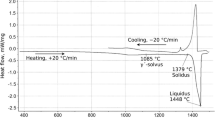Abstract
Interdiffusion in nickel (Ni)-chromium (Cr) (face-centered cubic γ phase) alloys with small additions of aluminum (Al), silicon (Si), germanium (Ge), or palladium (Pd) was investigated using solid-to-solid diffusion couples. Ni-Cr-X alloys having compositions of Ni-22at.% Cr, Ni-21at.%Cr-6.2at.%Al, Ni-22at.%Cr-4.0at.%Si, Ni-22at.%Cr-1.6at.%Ge, and Ni-22at.%Cr-1.6at.%Pd were manufactured by arc casting. The diffusion couples were assembled in an Invar steel jig, encapsulated in Ar after several hydrogen purges, and annealed at 900 °C in a three-zone tube furnace for 168 h. Experimental concentration profiles were determined from polished cross sections of these couples by using electron probe microanalysis with pure element standards. Interdiffusion fluxes of individual components were calculated directly from the experimental concentration profiles, and the moments of interdiffusion fluxes were examined to determine the average ternary interdiffusion coefficients. The effects of ternary alloying additions on the diffusional behavior of Ni-Cr-X alloys are presented in the light of the diffusional interactions and the formation of a protective Cr2O3 scale.
Similar content being viewed by others
References
C.T. Sims, N.S. Stoloff, and W.C. Hagel,Superalloys II, John Wiley and Sons, 1987
P. Kofsted, Growth and Protective Properties of Chromia (Cr2O3) and Alumina (Al2O3) Scales, Protective Coatings,High Temperature Corrosion, Elsevier, London, 1980, p 389–423
J.L. Smialek, C.A. Barrett, and J.C. Schaffer, Design for Oxidation Resistance,ASM Handbook, Vol. 20, Materials Selection and Design, George E. Dieter, Ed., ASM International, 1997, p 589–602
F.H. Stott, G.C. Wood, and M.G. Hobby, A Comparison of the Oxidation Behavior of Fe-Cr-Al, NI-Cr-Al and Co-Cr-Al Alloys,Oxid. Met., 1971,3, p 103–113
C.E. Lowell, A Scanning Electron Microscope Study of the Surface Morphology of TD-NiCr Oxidized at 800 °C to 1200 °C,Oxid. Met., 1972,5, p 205–220
C.E. Lowell, Cyclic and Isothermal Oxidation Behavior on Some Ni-Cr Alloys,Oxid. Met., 1973,7, p 95–115
G.M. Ecer and G.H. Meier, Oxidation of High-Ehromium Ni-Cr Alloys,Oxid. Met., 1979,13, p 119–158
G. Benabderrazik, G. Moulin, and A.M. Huntz, Relation Between Impurities and Oxide-Scale Growth Mechanisms on Ni-34Cr and Ni-20Cr Alloys: I. Influence of C, Mn, and Si,Oxid. Met., 1990,33, p 191–235
J.F. Schmitt, N. Pacia, P. Pigeat, and B. Weber, Study of the Initial Oxidation of a Ni-20Cr Alloy in the Temperature Range 550–830 °C: Influence of Mechanical Deformation,Oxid. Met., 1995,44, p 429–452
C.K. Kim and L.W. Hobbs, Microstructural Evidence for Short-Circuit Oxygen Diffusion Paths in the Oxidation of a Dilute Ni-Cr Alloy,Oxid. Met., 1996,45, p 247–265
B. Ahmad and P. Fox, STEM Analysis of the Transient Oxidation of a Ni-20Cr Alloy at High Temperature,Oxid. Met., 1998,52, p 113–138
J.R. Nicholls and M.J. Bennett, Cyclic Oxidation-Guidelines for Test Standardization, Aimed at the Assessment of Service Behavior,Mater. High Temp., 2000,17, p 413–428
B. Li and B. Gleeson, Effect of Silicon on Oxidation Behavior of Ni-Base Chromia-Forming Alloys,Oxid. Met., 2006,65, p 101–122
F.H. Stott, G.C. Wood, and J. Stringer, The Influence of Alloying Elements on the Development and Maintenance of Protective Scales,Oxid. Met., 1995,44, p 113–145
D.P. Whittle and J. Stringer, Improvements in High Temperature Oxidation Resistance by Additions of Reactive Elements or Oxide Dispersions,Proc. R. Soc. Lond., Ser. A, 1980,295, p 309–329
G.C. Wood and F.H. Scott, Oxidation of Metals,Mater. Sci. Technol., 1987,3, p 519–530
G.C. Wood, J.A. Richards, M.G. Hobby, and J. Boustead, Identification of Thin Healing Layers at Based of Oxide Scale on Fe-Cr Base Alloys,Corros. Sci., 1969,9, p 659–671
A.G. Revsz and F.P. Fehlner, The Role of Noncrystalline Films in the Oxidation and Corrosion of Metals,Oxid. Met., 1981,15, p 297–321
M.J. Bennett, J.A. Desport, and P.A. Labun, Analytical Electron Microscopy of a Selective Oxide Scale Formed on 20% Cr-25% Ni-Nb Stainless Steel,Oxid. Met., 1984,22, p 291–306
M.J. Bennett, J.A. Despota, and P.A. Labun, Transverse Microstructue of an Oxide Scale Formed on a 20%Cr-25%Ni-Nb Stabilized Stainless Steel,Proc. R. Soc. Lond., Ser. A, 1987,412, p 223–230
R.C. Lobb, J.A. Sasse, and H.E. Evans, Dependence of Oxidation Behavior on Silicon Content of 20%Cr Austenitic Steels,Mater. Sci. Technol., 1989,5, p 828–834
W.C. Hagel, Oxidation of Iron Nickel and Cobalt-Base Alloys Containing Aluminum,Corrosion, 1965,21, p 316–326
J.A. Nesbitt, Numerical Modeling of High-Temperature Corrosion Processes,Oxid. Met., 1995,44, p 309–338
H.E. Evans, A.T. Donaldson, and T.C. Gilmour, Mechanisms of Breakaway Oxidation and Application to a Chromia-Forming Steel,Oxid. Met., 1999,52, p 379–402
J.A. Nesbitt and R.W. Heckel, Interdiffusion in Ni-Rich, Ni-Cr-Al Alloys at 1100 and 1200°C: Part I. Diffusion Paths and Microstructures,Metall. Trans. A, 1987,18A, p 2061–2086
C.S. Giggin and F.S. Pettit, Oxidation of Ni-Cr-Al Alloys Between 1000 and 1200 °C,J. Electrochem. Soc., 1971,118, p 1782–1790
B.A. Pint, J.R. Keiser, “Alloy Selection for High Temperature Heat Exchangers,” NACE Paper 06-469, presented at NACE Corrosion 2006 (San Diego, CA), NACE International, March 2006
M.P. Brady, B. Gleeson, and I.G. Wright, Alloy Design Strategies for Promoting Protective Oxide Scale Formation,JOM, 2000,52, p 16–21
D.J. Young and B. Gleeson, Alloy Phase Transformations Driven by High Temperature Corrosion Processes,Corros. Sci., 2002,44, p 345–357
L. Onsager, Theories and Problems of Liquid Diffusion,Ann. N. Y. Acad. Sci., 1965,46, p 241–265
M.A. Dayananda and C.W. Kim, Zero-Flux Planes and Flux Reversals in Cu-Ni-Zn Diffusion Couples,Metall. Trans. A, 1979,10A, p 1333–1339
M.A. Dayananda and Y.H. Sohn, Average Effective Interdiffusion Coefficients and Their Applications for Isothermal Multicomponent Diffusion Couples,Scr. Mater., 1996,40, p 683–688
M.A. Dayananda and Y.H. Sohn, A New Approach for the Determination of Interdiffusion Coefficients in Ternary Systems,Metall. Mater. Trans. A, 1999,30A, p 535–543
M.S. Thompson, J.E. Morral, and A.D. Romig Jr., Applications of the Square Root Diffusivity to Diffusion in Ni-Al-Cr Alloys,Metall. Trans. A, 1990,21A, p 2679–2685
Author information
Authors and Affiliations
Rights and permissions
About this article
Cite this article
Garimella, N., Sohn, Y. & Brady, M.P. Interdiffusion in γ (face-centered cubic) Ni-Cr-X (X=Al, Si, Ge, or Pd) alloys at 900 °C. JPED 27, 665–670 (2006). https://doi.org/10.1007/BF02736570
Received:
Revised:
Issue Date:
DOI: https://doi.org/10.1007/BF02736570




